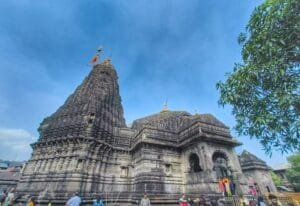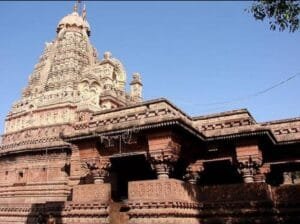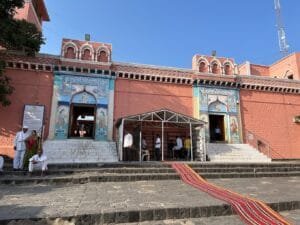
Introduction to Jyotirlingas

In Hinduism, Jyotirlingas are highly revered shrines dedicated to Lord Shiva, one of the principal deities in the religion. The term ‘Jyotirlinga’ is derived from ‘jyoti,’ meaning light or radiance, and ‘linga,’ signifying the emblem of Lord Shiva. Each Jyotirlinga is considered a manifestation of Shiva and embodies the divine energy and light of this deity. According to ancient scriptures, there are a total of twelve Jyotirlingas scattered across India, each representing a unique aspect of Shiva.
Book Best Cab Service for 3 Jyotirlinga in Maharashtra Tour
The significance of these sacred sites extends beyond mere worship; they serve as pilgrimage destinations that facilitate spiritual rejuvenation and connection with the divine. Devotees believe that visiting these Jyotirlingas and offering prayers can bestow blessings, fulfill wishes, and offer liberation from the cycle of birth and rebirth. The twelve Jyotirlingas are mentioned in various texts, including the Shiva Purana, which elaborates on the legends and beliefs associated with each shrine, illustrating their importance in Hindu mythology.
Maharashtra is home to five of these revered Jyotirlingas, which include important temples such as those at Trimbak, Bhimashankar, and Grishneshwar. Each of these sites has its own unique history and cultural significance, attracting countless pilgrims and tourists alike. The shrines not only stand as symbols of faith but also highlight the rich heritage and architectural grandeur of Maharashtra. The presence of these Jyotirlingas in the state enhances its spiritual landscape, making it a vital center for worshippers seeking solace and divine connection. As we delve deeper into the exploration of these sacred sites, we begin to understand their historical, spiritual, and cultural relevance within the broader framework of Hinduism.
Trimbakeshwar Jyotirlinga
Trimbakeshwar Shiva Temp
Situated in Nashik, the Trimbakeshwar Jyotirlinga is one of the most revered shrines in Hinduism, dedicated to Lord Shiva. This ancient temple, believed to have been constructed in the 18th century, showcases exquisite architectural features typical of the period, including intricate carvings and sculpted pillars. Its design reflects a unique blend of spirituality and artistry, making it a significant landmark in the region.
Historical records suggest that the temple was initially built under the patronage of the Maratha ruler, Chhatrapati Shivaji Maharaj, who aimed to revive the ancient customs and practices associated with the worship of Shiva. The jyotirlinga itself is distinct, representing a three-faced deity symbolizing Brahma, Vishnu, and Shiva, a concept that emphasizes the belief in the unity of divine forms. This representation draws pilgrims seeking to understand the deeper spiritual significance of the various aspects of the divine.
The legends associated with the Trimbakeshwar Jyotirlinga are both fascinating and deeply rooted in mythology. It is said that the temple was born out of a curse placed on Lord Brahma and Lord Vishnu, compelling them to worship Shiva in this very place. Over the years, the temple has become a focal point for spiritual seekers and devotees alike, further amplified by the presence of the sacred Godavari River, which originates nearby. The river holds a Janmabhoomi significance, believed to cleanse sins and foster spiritual purification.
Throughout the year, the temple attracts a significant number of pilgrims, especially during the annual Kumbh Mela, which is hosted in Nashik once every twelve years. This event draws thousands, creating a vibrant atmosphere filled with devotion and fervor. The rituals and ceremonies conducted at the Trimbakeshwar Jyotirlinga highlight the rich cultural heritage of the region, making it a pivotal hub for worship and spiritual connection.
Grishneshwar and Bhimashankar Jyotirlingas

The Grishneshwar Jyotirlinga is situated near the historical Ellora caves, which are renowned for their magnificent rock-cut architecture and intricate sculptures. Grishneshwar holds the distinction of being the last in the revered list of the twelve Jyotirlingas, each representing a unique manifestation of Lord Shiva. The temple of Grishneshwar is a significant pilgrimage site, drawing numerous devotees who come to pay homage and seek blessings. It is believed that visiting this sacred site brings about spiritual purity and awakens devotion, as it is deeply connected to various local legends, including the tale of a devoted woman who persisted in her faith while facing adversity.
In addition to its spiritual relevance, Grishneshwar’s proximity to the stunning Ellora caves enhances its significance. Tourists often combine their pilgrimage with visits to these caves, which house awe-inspiring monasteries and temples carved out of volcanic rock. The annual festivals, particularly Mahashivratri, see a considerable influx of visitors, turning the area into a vibrant hub of religious activities that includes rituals, prayers, and traditional music.

On the other hand, the Bhimashankar Jyotirlinga is nestled in the picturesque Sahyadri mountain range, known for its lush greenery and breathtaking landscapes. Bhimashankar is not only significant for its religious importance but also for its rich biodiversity, as it is located within a wildlife sanctuary. The temple dedicated to Bhimashankar is renowned for its unique architecture and serene atmosphere, making it an ideal destination for both spiritual seekers and nature enthusiasts.
The rituals performed at Bhimashankar, coupled with the vibrant festivals throughout the year, attract countless devotees. Visitors partake in special prayers and offer their gratitude, making it a lively spiritual encounter. According to local legends, this Jyotirlinga is associated with the legendary battle between Lord Shiva and the demon Tripurasura, further embellishing its historical and mythological importance. The blend of natural beauty and rich cultural heritage at both Grishneshwar and Bhimashankar enhances their status as revered Jyotirlingas in Maharashtra.
Trimbakeshwar, Grishneshwar and Bhimashankar are More Popular and, attracts large number of devotees world wide. And known as Famous 3 Jyotirlinga’s in Maharashtra.
Book best tour package for 3 Jyotirlinga in Maharashtra with Maharashtra Jyotirlinga Citycabz.
Aundha Nagnath and Parli Vaijnath Jyotirlingas

The Aundha Nagnath and Parli Vaijnath Jyotirlingas are two significant sites within the revered Panch Jyotirlingas pilgrimage circuit in Maharashtra. Each site boasts unique architectural features and profound cultural importance, attracting devotees and tourists alike. Aundha Nagnath, dedicated to Lord Shiva, showcases exceptional architectural intricacies characteristic of ancient Indian temple design. The temple is primarily known for its exquisite stone carvings, which depict various deities and mythological figures, thereby enhancing its spiritual atmosphere.
During the grand festival of Maha Shivaratri, Aundha Nagnath witnesses an influx of devotees who come to participate in the numerous rituals and celebrations that take place over the festival days. This festival not only highlights the temple’s religious significance but also reinforces its role as a community hub where local traditions and cultural practices are actively preserved. The participation of the locals further strengthens the temple’s bond with the community, creating an environment rich in devotion and collective consciousness.
In contrast, Parli Vaijnath holds a distinguished position in the hearts of devotees due to its association with healing and wellness. The temple of Vaijnath is renowned for its beliefs surrounding the curative powers of the deity, attracting pilgrims seeking both spiritual and physical healing. With its serene ambiance and tranquil surroundings, Parli Vaijnath serves as a sanctuary for countless devotees who come to offer prayers and seek solace.
Both Aundha Nagnath and Parli Vaijnath contribute meaningfully to the overall fabric of pilgrimage in Maharashtra. Their individual significance, whether through architectural excellence or healing associations, enhances the collective experience of visiting the Panch Jyotirlingas. As places deeply embedded in spiritual traditions, they continue to resonate with the essence of faith and devotion among pilgrims who seek divine connection and transcendence.
If you are coming to visit shivling temple near Mumbai and Pune. then we Citycabz Holiday’s has best Jyotirlinga Tour Package that takes you to 3 and 5 jyotirlingas temple within 2 days.
If you extend to 3 days then you can also visit shirdi sai baba temple, famous UNESCO World Heritage site Ellora & Ajanta Caves, Panchwati Nashik, Shani Singapur and Aurangabad Sieghtseeing.
Need Best Deal Contact Citycabz at 24×7 Customer Support Number Call/WhatsApp : +91 93720 93020.
Book 5 jyotirlinga in Maharashtra Tour Package with Citycabz at best price
